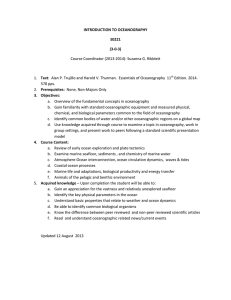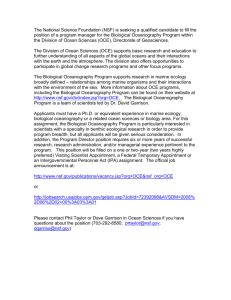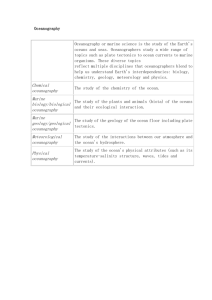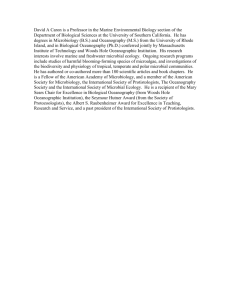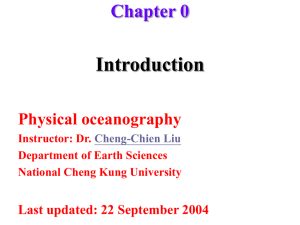S p e c i a l i...
advertisement
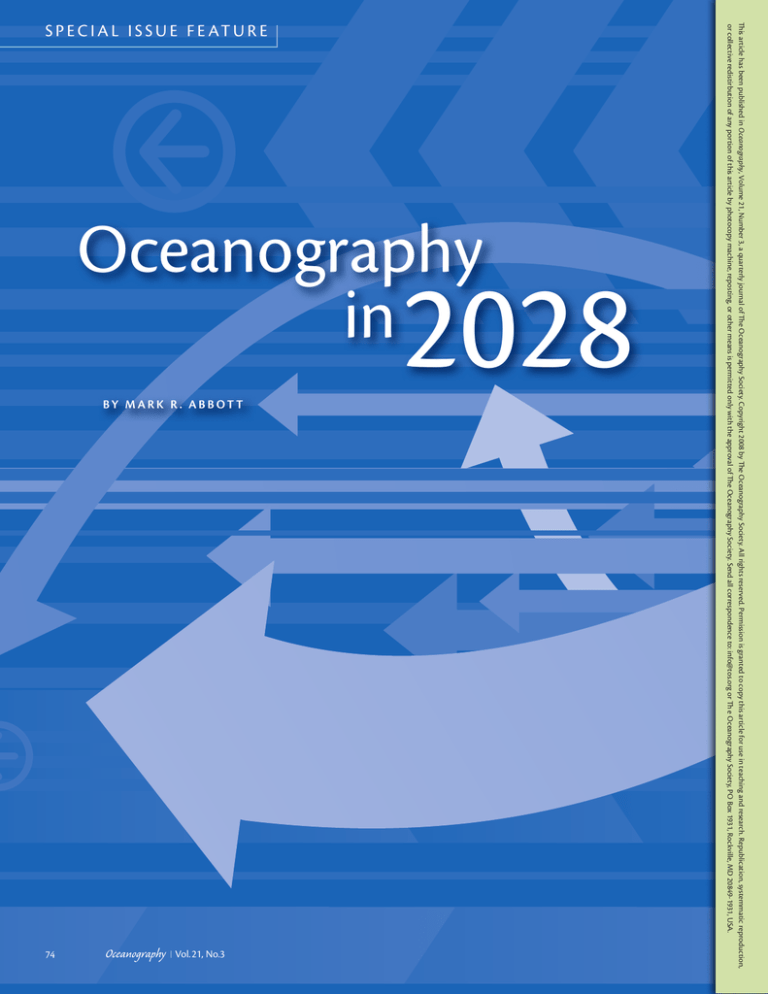
B y M a r k R . Abb o t t Vol.21, No.3 Oceanography 74 2028 This article has been published in Oceanography, Volume 21, Number 3, a quarterly journal of The Oceanography Society. Copyright 2008 by The Oceanography Society. All rights reserved. Permission is granted to copy this article for use in teaching and research. Republication, systemmatic reproduction, or collective redistirbution of any portion of this article by photocopy machine, reposting, or other means is permitted only with the approval of The Oceanography Society. Send all correspondence to: info@tos.org or Th e Oceanography Society, PO Box 1931, Rockville, MD 20849-1931, USA. S p e c i a l Iss u e F e at u r e Oceanography in P r e d i c t i n g t h e f u t u r e is an interesting, if somewhat futile, exercise, but at the least it can provoke us to think about where we are and where we might be headed. We can (a) project forward our wishful thinking, (b) assume that there will be little or no change in how we operate—or (c) assume that no one will remember our forecasts, so what we say is of little importance. In the “eternal optimist” case, we could detail all of our existing challenges and concerns and assume that somehow the situation will change. For example, somehow the community raises a $1 billion endowment to support long-term ocean observations (Baker et al., 2007). In the “nothing ever changes” case, the past and present situations look nearly the same, and thus we assume persistence. This circumstance is analogous to weather forecasting: tomorrow’s weather will most probably be like today’s. Given the long-term persistence of academic institutions, this assumption may be reasonable. Lastly, the case of “no one will remember” allows us to make a set of outlandish predictions that bear little chance of coming to fruition. Our risk of embarrassment is low, as the probability that anyone will remember reading our predictions declines exponentially with time. Rather than choose any of these three paths, I intend to follow a different direction for this article and consider the evolutionary pressures that have brought us to our present state and how these forces will likely change. I also note that my focus is only on oceanography in the United States. Some of the issues will have global connections, but the focus of this article is on US institutional structures and the forces that buffet them now and will affect them into the future. In general, institutions and communities perceive the past as stable, and the mechanisms and processes that are developed generally assume continuation of this stable environment. But any large changes or unforeseen linkages will result in a much different “environment,” and our structures and processes may or may not be suitable for it. Our field has evolved in an environment where most funding comes from federal agencies to support research and graduate students. Thus, we have little in the way of state support or industrial partnerships, and philanthropic support varies widely from institution to institution. One of the results of this funding environment is an academic field dominated by a few institutions (about 80% of National Science Foundation Division of Ocean Sciences [NSF/OCE] research funding goes to the early members of Joint Oceanographic Institutions, Inc.: Lamont-Doherty Earth Observatory, Oregon State University, Rosenstiel School of Marine and Atmospheric Science, Scripps Institution of Oceanography, Texas A&M University, University of Hawai’i, University of Rhode Island, University of Washington, and Woods Hole Oceanographic Institution). The remaining member institutions of the newly formed Consortium for Ocean Leadership generally specialize in a few areas of ocean research or are parts of larger science programs within their universities. Oceanography September 2008 75 Where We Are Today This business model has served the nation well as documented by the National Research Council (NRC) in a comprehensive overview of both the scientific and programmatic aspects of ocean sciences (NRC, 2000). Although this publication focuses exclusively on NSF, it notes linkages with other federal agencies, notably the Office of Naval Research (ONR), the National Oceanic and Atmospheric Administration (NOAA), the National Aeronautics and Space Administration (NASA), and the Department of Energy (DOE). Although the basic federal-funding model has persisted for several decades, there is increasing dominance by NSF in academic funding, with a shrinking level of support from ONR and a short-term (roughly 10-year) flowering of support by NASA in the 1990s. This change in the funding portfolio has had subtle, but significant, impacts on the field. As noted by Wunsch (1989), the traditional three-year, competitive grant cycle favored by NSF presents significant obstacles to the development of ocean instrumentation. Such high-risk activities often do not fare well in the peer review system because the outcomes are less certain than research-focused proposals. Sustaining long time series is another challenge within the NSF funding environment. Eventually, such programs seem more akin to “monitoring” and more appropriate for a mission agency such as NOAA. The history of the Mauna Loa Mark R. Abbott (mark@coas.oregonstate. edu) is Dean, College of Oceanic and Atmospheric Sciences, Oregon State University, Corvallis, OR, USA. 76 Oceanography Vol.21, No.3 CO2 time series presents some useful lessons on the rewards and tribulations of such activities (Keeling, 2008). Lastly, the research fleet (both operations and fleet renewal) has become an increasing burden on NSF, with the result that the number of ships is likely to decline significantly over the next 10 years as older vessels are retired and the costs for new ones continue to escalate. Ships and other infrastructure costs have grown from about 37% of the NSF/OCE budget to about 43%. One aspect of academic research life has clearly not changed: the importance of individual accomplishment in the areas of teaching, research, and service. With the growth in NSF funding over the last 20 years (NSF’s Research and Related Activities budget has nearly doubled after adjusting for inflation), universities have added to their research capacity by expanding their research facilities and hiring faculty (though primarily “soft” money faculty). A recent study by NSF (2007) showed that the “researchintensive” universities accounted for most of the growth in proposal submissions, but the share of proposals from non-research-intensive universities has grown significantly. Moreover, many more proposal submissions now list multiple principal investigators (PIs) rather than single PIs (26% in FY97 compared to 44% in FY06). Similar changes in the number and structure of proposal submissions apply to NSF/OCE. Increasing competition (success rates at NSF have dropped from around 40% to around 30% over the last decade) and the increase in multiple-investigator awards results in additional strains on young faculty trying to achieve tenure, especially when universities are placing increasing emphasis on grants and publications. Although one would think that multi-PI grants would have little impact on tenure decisions (especially in an inherently interdisciplinary field such as oceanography), many universities question the level of contribution to the effort by each faculty member (and some programs actually discourage such multi-PI grants). Force s for Change If these were the only forces of change, then simply increasing the level of funding to the ocean sciences would largely solve all of the problems. One of the underlying recommendations of the report of the US Commission on Ocean Policy (2004) was the need to increase the percentage of federal research and development (R&D) funding to its historical levels (it has decreased in the last 25 years from 7% to 3.5%). The Commission also focused on the need for a changed governance structure for the coastal zone and the ocean, as well as on the changing nature of the policy issues confronting the nation and the types of science needed to support effective policy and management. Moreover, the Commission addressed most of its recommendations to the mission agencies, especially NOAA, as opposed to NSF, which provides most of the support to the academic enterprise in oceanography. Therefore, even the proposed increase in funding would likely be directed at a new class of science issues that would force new partnerships and new directions at academic institutions. Change in the nature of science questions is a hallmark of all science, not just oceanography. Forty years ago, physical oceanographic research focused on issues relevant to military concerns, such as ocean mixing, sound scattering, and mesoscale eddies, which would affect the ability to detect submarines. But tomorrow’s concerns and challenges will require a far higher level of integration of science across the Earth system, including the oft-neglected human dimension. For example, how might Gulf Coast hurricane frequency and intensity change over the next decade, how would this affect human migration out of the area, where would these people move, and what sort of physical and social infrastructure would be needed in the new settlement areas? Our community has adapted in the past and will in the future to the changing nature of the science, the issues of importance to society, and the analytical and observing tools that are available. However, these changes in science questions and directions are more at the level of adaptation, rather than fundamental changes in organizational and cultural structure and function. The academic community has developed strategies to ensure the survival of a scientific enterprise that is inherently restless, worshipful of growth, and very expensive (Greenberg, 2001). But have we become ossified to the extent that it is difficult to create new institutions and organizations and nearly impossible to eliminate old ones? Rich institutions seem to require ever more resources, rather than examining the way they operate to identify efficiencies, and new organizations struggle to establish their credentials among their peers. Have our research institutions (and even our culture) become so deeply invested in their present structures that they will fail before they recognize and respond to a changing world? Or, will our response to these changes lose sight of our underlying purpose and values? Change for change’s sake is as fraught with danger as resisting all change. At the beginning of the twenty-first century, oceanography (and much of the academic research enterprise) is faced with a world where the model of persistence for forecasting is likely to fail in unexpected ways. More oceanographers are chasing after funds that are unlikely to grow at a rate that will even satisfy academic population growth (which is about 10% per year for new PhDs in ocean sciences). With universities placing ever-increasing importance on grants and publications for promotion decisions, the field will experience an even harsher competitive environment. Universities will not be able to accommodate their needs even with a growing federal budget, and they will begin to pursue new sources of revenue such as state governments, corporations, private foundations, and even foreign governments. But these will be forces for change, not persistence. State governments have different issues and levels of accountability than NSF or the federal mission agencies. Corporations operate on different time scales with very different expectations, processes, and rules of engagement than academia. A few private foundations fund basic research in much the same way as NSF (although often they are unwilling to pay the full indirect cost rate to universities), but many are more interested in funding advocacy or education efforts than basic research. Although foreign governments bring their own issues, several US universities as well as the Woods Hole Oceanographic Institution have recently developed partnerships with King Abdullah University of Science and Technology (KAUST) of Saudi Arabia. Such alliances may face local opposition; for example, the recent agreement between the University of California, Berkeley, and KAUST to develop a college of engineering has generated concern and some resistance from faculty. Even if these new sources of funding come to fruition, they are likely to bring a new set of conditions and requirements, many of which will be either unfamiliar or unacceptable to academia. Unconstrained, high-risk research (sometimes known as transformative or curiosity-driven research) will be even more of a rarity, although the inherent conservativeness of the peer review system has already limited the success of such proposals (Braben, 2008). These issues are part of a larger debate about the role of academic institutions in regard to teaching and research (although this debate does not take place in an open forum; rather, it is a set of skirmishes over smaller issues). The “Boyer Report” (Boyer Commission on Educating Undergraduates in the Research University, 1998) discusses the issues facing research universities (especially public research universities) in balancing the need for undergraduate teaching with the need for research. Although universities continue to stress teaching over research in their public pronouncements, the reality is that the expectations for faculty success as well as the investments in infrastructure are largely driven by the needs of the research enterprise. Universities have made enormous investments in physical infrastructure (which, by the way, drive up indirect cost rates) in order to remain competitive. Moreover, university Oceanography September 2008 77 research is now seen as an economic engine by state legislatures. On a global scale, the NRC (2007a) makes it clear that investments in basic science are essential for the continued competitiveness of the United States in the global economy. However, it remains to be seen how much patience federal and state legislatures will have in regard to outcomes from this renewed commitment to basic research and higher education. And these efforts still do not address the continuing disconnect between the research enterprise and undergraduate education. Braben (2008) views both of these new directions for universities (increased economic competitiveness and focus on undergraduate access) as great burdens on the ability of academia to maintain unconstrained creativity. He argues that there is a specific need for “transformative research,” the exploration of new concepts and directions that do not necessarily fit within a prioritized research program or fare well in the inherently conservative peer review system. Such “unconstrained” research may need new organizations and new approaches. Simply fine-tuning existing universities or federal programs will not move research out of its existing trajectory of prioritized and “directed” research. Two interconnected forces for change are often not recognized by the scientific community: globalization and the next wave of information technology (or, to use NSF terminology, cyberinfrastructure). In the first area, several questions arise. Can knowledge and research be outsourced? With increasing levels of globalization, can governments and businesses just purchase the research they need from anywhere in the world? Physical place and collocation of work 78 Oceanography Vol.21, No.3 groups is less important than access to the best available talent. In the area of cyberinfrastructure (CI), there have been several important shifts over the last decade. First, the near-ubiquitous deployment of a range of networks linking a wide variety of devices has transformed our model of a PC or a computer terminal linked to a mainframe into something much more dynamic and transitory. Universities must supply the increasingly diverse services provided to ordinary consumers, which may generate a range of unforeseen impacts. For example, if research can be conducted effectively by accessing networked resources (e.g., sensors, digital libraries, collaborators), then how can universities justify their indirect cost structures if faculty (or individual, nonaffiliated scientists) are working outside the university? Second, nearly every component of CI has moved into the commodity marketplace. This transfer is not just as simple as saying that cost/ performance ratios continue to drop, but rather that there is a new set of expectations on the part of the consumer as well as new time scales of innovation. Users must know how to evaluate and integrate these updated technologies; there will be little pre- or post-sale support. The rapid innovation cycle will stress both academics and funding agencies. Are the funding agencies positioned to provide the technical and financial infrastructure necessary or will they insist that such CI should be part of the base-level support for research provided by universities through their indirect charges? Third, the traditional balances of control and authority have shifted. The relatively slow, well-defined process of data collection, analysis, manuscript preparation, peer review, and publication has been transformed, not simply replaced, with an online process. Several initiatives are underway to explore new methods of scientific publication, but just as Wikipedia is not just an online encyclopedia, these new “journals” have the potential to transform how we conduct and communicate science. Jumars (2008) discusses some of these new models and their impacts on scientific societies that traditionally have depended on journals as a revenue source. Similar pressures for change are confronting the educational mission of universities as well; will the availability of more coursework online create the sense of higher education as a commodity that can be purchased anywhere with a far different assessment of value by students than we have today? Will the process of mass customization that is enabled by local access to high bandwidth, high processing power, and enormous data storage capabilities eclipse the centralized, mass-produced goods and services of the twentieth century? A New World for the O ce an Science s? I have discussed three forces (and there are likely many more) that will change the environment for our field over the next 20 years, although many would argue that the first two forces have already begun to reshape our community. First, federal funding will not grow at a rate sufficient to accommodate our needs or even the growing number of oceanography faculty. Second, even if new sources of funding become available, they will bring new expectations and new requirements. Third, the interconnected forces of globalization and CI open up new opportunities as well as challenges for our institutions and culture. Because of its position as a federally funded, graduate-focused academic program, oceanography will respond to these forces differently than other academic programs that have stronger ties to the educational mission. Oceanography’s dependence on community-based infrastructure (notably ships) also serves as a unifying element for our research culture. Thus, our ability to respond to change will be controlled by the organizations and processes that we have developed over the last century. Budget and political pressures will lead to a restructuring of our institutions by 2028. The smaller oceanography programs (those that average less than $1.5M/year from NSF/OCE) will likely continue much as they are today, focused primarily on teaching with some summer salary for faculty research. They are generally well connected with other elements of the teaching programs and thus are buffered from the unpredictability of federal funding. Many of the mid-size and very large programs will experience significant change. (I define “mid-size” as those programs that have received, on average, between $1.5M and $5M/year of NSF/OCE funding over the last decade, while “very large” institutions are those that receive more than $5M/year.) A small number of the very large programs will persist largely unchanged although their programs will be under continuing and increasing financial pressure. One or two might be significantly transformed and become part of a larger Earth system observing and forecasting enterprise. Some of the mid-size and very large programs will be absorbed into larger schools and colleges that will emphasize basic science education at the undergraduate level, and these education programs will look different from today’s discipline-based majors. In an effort to attract students to universities with physical campuses (rather than lessexpensive online offerings), programs competitive pressures for funding, it is likely that several of these businesses will fail or they will pursue research lines that are beyond those of today’s oceanographic research programs. Some will develop new business models, perhaps with university faculty running all of their grants through the private company but retaining a tenure-based How we as individual oceanographers, as individual institutions, and as a community choose to recognize and respond to these changes will set the course for our field for many decades. will develop hands-on internships and research experiences. Ocean education will no longer be focused on graduate education but will be a “signature” research experience for undergraduates. It might be part of a basic science curriculum, or it could be blended into programs of environmental or Earth system science. Research that remains at these teaching-focused institutions will look more like other academic programs: nine months of “hard” support for teaching and an option for three months of summer salary supported by extramural funds. Other research programs will be spun off from the now teaching-focused institutions, with the expectation that oceanographers can be fully self-supporting through grants and contracts. Some of these researchers will form consulting firms; others may form companies that remain loosely coupled to their former universities. Given the “safety net” at a university for teaching. Or, will there be shifting collaborations of scientists that form and dissolve depending on the scientific question and the source of funding? With the nature of the scientific questions requiring a higher level of interdisciplinary collaboration (including socioeconomic and policy studies), such new, nonacademic organizations may bring much-needed flexibility compared to the traditional, discipline-bound and individual-focused academic promotion and tenure process. These organizations might even be more appealing to young scientists than the harsh competition and insecurity of a tenure-track faculty position. By 2028, I expect that there will be far more corporate interest in some types of ocean research at academic institutions, not just scientific consulting firms. Along with expanded interests in ocean resources (e.g., open-ocean Oceanography September 2008 79 aquaculture, deep-sea resource extraction, wave energy), new opportunities will appear, such as iron fertilization as a carbon offset and phytoplankton as an energy source. New services will also be developed to support a range of riskbased investments for hedge funds, such as those associated with the reinsurance industry and hurricanes. Schneider (2008) suggests that even fundamental research might be funded through such financial instruments. These new corporate relationships will entail far more engagement on the part of faculty than in the past: are the scientists representing the science or are they advocating for specific programs that will generate significant personal benefit? Much as in the biomedical arena, some oceanographers will test the limits of conflicts of interest between their research interests and their personal financial interests. Greenberg (2007) discusses how these forces have tested the scientific community and their universities, not always with positive results. Philanthropic support will also increase, but most of these new funds will be targeted towards specific research programs or advocacy and education programs. Even these funds will be hard to come by, given that every university and college is engaged in endless fundraising campaigns. If oceanographic institutions become engaged with foundations and their advocacy programs, then there will be a whole new area of political engagement at the institutional level. Academic organizations have generally avoided such engagements (at least at a level that involves funding), but as the search for funding becomes more intense and the recognition of ocean issues expands, it is likely that some 80 Oceanography Vol.21, No.3 institutions will not resist the lure. As the existing oceanographic programs and institutions consolidate, restructure, or transform themselves, there will be significant impacts on the research fleet. We are on a trajectory today where there will be significantly fewer ship days available; there will be increasing emphasis by the agencies to further reduce operating costs. Analogous to the “standardization” on community models of coupled ocean/ atmosphere processes, observing systems will become more standardized, with a greater reliance on gliders, cabled observatories, and other autonomous systems that need much less ship support. The satellite remote sensing community has relied on such standardized data products for years. Although this approach clearly has many advantages, it does represent a fundamental shift from scientists who develop their own tools and approaches to scientists who are “consumers” of standard data products. This shift has been taking place for years: how many students prefer to use interpreted languages such as MATLAB rather than coding their own analysis routines in C? While, at some level, this shift to science consumers is a good thing, it does have a set of potentially negative impacts. For example, who will develop the next generation of science instruments? Are we training students in the appropriate way to balance the need to create new techniques and approaches with the need to be able to use standardized tools and data? Will CI that is developed to meet the needs of consumers and the entertainment industry continue to meet the needs of the scientific community? Will the sense of community engendered through the use of shared facilities be disrupted as the costs of these facilities compete for funds at the expense of support for principal investigators? Twenty years from now, there will be a different mix of institutions and structures than we have at present. Some oceanographic programs will be absorbed into larger academic enterprises. Others will pursue more commercial opportunities on an international basis. A few institutions may persist largely unchanged, in part because of inertia. And some new organizational structures may emerge to exploit new scientific issues and new levels of collaboration. It will be a different world for oceanographic institutions, but similar changes have occurred in the forestry schools around the country. Built largely on partnerships between industry and the federal government, these schools have seen the nature of science issues, societal concerns, and funding shift significantly in recent decades. Many programs are much smaller than they once were. Others have been consolidated into larger programs of natural resources or environmental science. There are lessons to be learned from this evolution. Similarly, engineering programs are wrestling with changes in the global nature of the field and the types of issues and technologies that are driving the field (Duderstadt, 2008). There are forces that we cannot control, but an honest recognition of them and a broad ranging and open discussion of their impacts could at least enable the oceanographic community to make conscious, proactive decisions. The choice is to follow a directed path of evolution, or simply respond as individuals and individual institutions to the twists and turns of change. Here are five actions that we could begin now to take control of our future: 1. We need to move beyond the traditional discipline-based model of oceanography graduate education (which grew largely out of the Sverdrup, Johnson, and Fleming textbook [1942]) and infuse oceanography into an undergraduate science curriculum that relies on hands-on research experience. Oceanography could serve as a framework for teaching the fundamental sciences (physics, chemistry, and biology) and mathematics. 2. We need to develop new business models for oceanographic research that are not frozen in the present structures of tenure-based academic institutions or purely soft-money research businesses. Broadly based, interdisciplinary research teams do not fit comfortably within the rigid department-based environment of tenure, but they do need long-term stability and persistence to enable high-risk science that is often lacking in consulting firms driven by shortterm needs for profitability. For example, rolling contracts (e.g., five-year contracts that are evaluated and renewed annually) may balance stability and flexibility, as well as allow researchers to balance life and work. 3. We need to engage the funding agencies as well as the private sector to develop new instrumentation that leverages modern design tools and capabilities, rather than simply tweaking the approaches of the past 30 years. The ocean is a harsh environment, but this is not an excuse for continuing to rely on traditional instrument designs. 4. We must work as a community to develop principles and establish processes that can balance the needs of community-based facilities and individual and team-based science. The only mechanism in place now is the constraint of funding availability. 5. We must position ocean research and education within a larger context of the Earth as a system. This construct does not mean abandoning the unique vision and capabilities of oceanography. Rather, it means that we cannot rely on the arguments of the past to move us into the future. Arguing for both public and private support on the basis of some perceived entitlement will not be effective. We must demonstrate both our willingness to understand the larger environmental issues facing society and our ability to inform decision-making with the best science. We will experience as many changes over the next 20 years as we have over the past two decades. Who could have foreseen the dramatic decline in seagoing oceanography just as the World Ocean Circulation Experiment (WOCE) and Joint Global Ocean Flux Study (JGOFS) were beginning in the mid 1980s or that an Earth observing system, which was in the midst of coming to fruition in the mid-1990s, would now be on the cusp of an “observational collapse” (NRC, 2007b)? The changes in the next 20 years will be more profound and more uncertain. How we as individual oceanographers, as individual institutions, and as a community choose to recognize and respond to these changes will set the course for our field for many decades. Reference s Baker, D.J., R.W. Schmitt, and C. Wunsch. 2007. Commentary: Endowments and new institutions for long-term observations. Oceanography 20(4):10–14. Boyer Commission on Educating Undergraduates in the Research University. 1998. Reinventing Undergraduate Education: A Blueprint for America’s Research Universities, Stony Brook University, 46 pp. Available online at: http://naples.cc.sunysb. edu/Pres/boyer.nsf/ (accessed June 3, 2008). Braben, D.W. 2008. Scientific Freedom: The Elixir of Civilization. Wiley-Interscience, 184 pp. Duderstadt, J.J. 2008. Engineering for a Changing World: A Roadmap to the Future of Engineering Practice, Research, and Education. The Millennium Project, University of Michigan, 119 pp. Available online at: http://milproj.dc.umich.edu/publications/EngFlex_report/index.html (accessed June 3, 2008). Greenberg, D.S. 2001. Science, Money, and Politics: Political Triumph and Ethical Erosion. University of Chicago Press, 540 pp. Greenberg, D.S. 2007. Science for Sale: The Perils, Rewards, and Delusions of Campus Capitalism. University of Chicago Press, 288 pp. Jumars, P.A. 2008. Charting a course through the rip tides, cross currents, and undertows of scientific journal publishing. Limnology and Oceanography Bulletin 17:2–8. Keeling, R.F. 2008. Recording Earth’s vital signs. Science 319:1,771–1,772. National Research Council. 2000. 50 Years of Ocean Discovery: National Science Foundation, 1950–2000. National Academies Press, 278 pp. National Research Council. 2007a. Rising Above the Gathering Storm: Energizing and Employing America for a Brighter Economic Future. National Academies Press, 592 pp. National Research Council. 2007b. Earth Science and Applications from Space: National Imperatives for the Next Decade and Beyond. National Academies Press, 428 pp. National Science Foundation. 2007. Impact of Proposal and Award Management Mechanisms. Final Report, NSF 07-45, 57 pp. Available online at: http://www. nsf.gov/pubs/2007/nsf0745/nsf0745.pdf (accessed June 3, 2008). Schneider, D. 2008. A market for basic science? American Scientist 96:203–204. Sverdrup, H.U., M.W. Johnson, and R.W. Fleming. 1942. The Oceans: Their Physics, Chemistry and General Biology. Prentice-Hall, Englewood, NJ, 1060 pp. US Commission on Ocean Policy. 2004. An Ocean Blueprint for the 21st Century. Final Report. Available online at: http://www.oceancommission. gov/documents/full_color_rpt/welcome.html (accessed June 3, 2008). Wunsch, C. 1989. Comments on oceanographic instrumentation development. Oceanography 2:26–27. Oceanography September 2008 81
